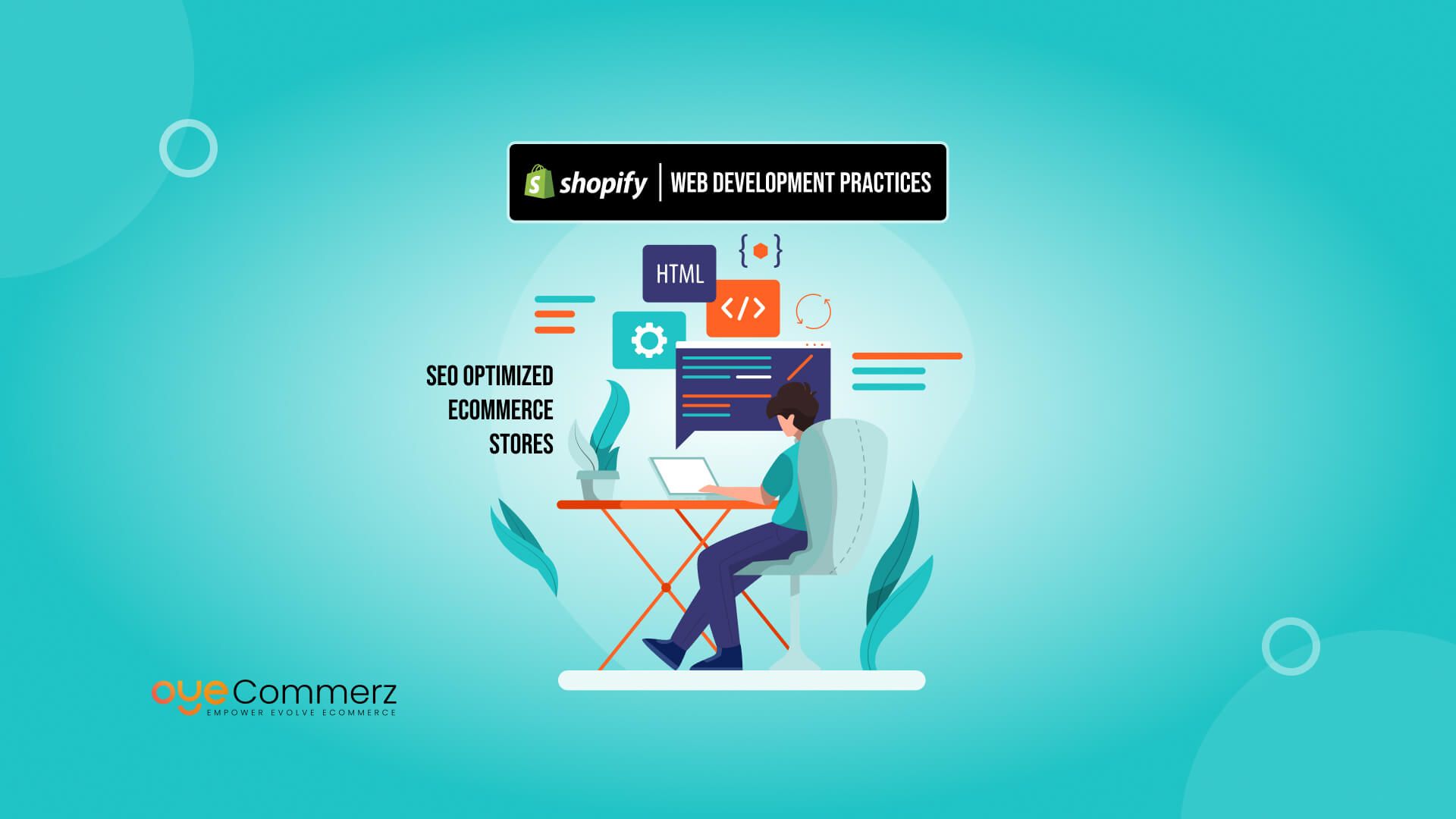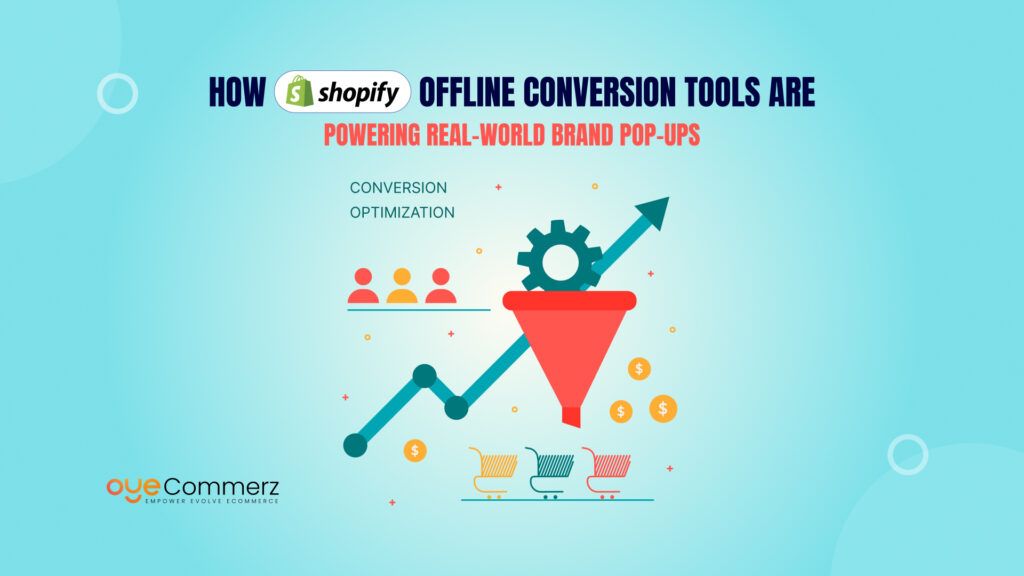Is your Shopify store struggling to rank higher on Google? You’re not alone! Many eCommerce businesses face this challenge, often wondering why their beautifully designed stores aren’t bringing in enough organic traffic. In today’s digital world, SEO (Search Engine Optimization) is no longer optional, it’s a must for any online store looking to thrive. A well-optimized Shopify store not only attracts more visitors but also converts them into loyal customers.
In this blog, we’ll dive into the best Shopify web development practices that can give your store a competitive edge. From improving site structure and optimizing product pages to leveraging advanced SEO techniques, these actionable tips will help your store rank higher, drive more traffic, and ultimately boost your sales. Whether you’re just starting out or looking to enhance your current SEO strategy, this guide will set you on the right path to success. Let’s get started!
Table of Contents
ToggleUnderstanding the Basics of Shopify SEO
Shopify SEO is the process of optimizing a Shopify store to improve its search engine rankings and attract more organic traffic. While traditional SEO focuses on optimizing websites in general, Shopify SEO is specifically tailored to the Shopify platform, taking advantage of its built-in features and overcoming its unique challenges.
Shopify comes with several SEO-friendly tools that make optimization easier. It automatically generates a sitemap.xml and robots.txt file, helping search engines crawl your site more efficiently. Additionally, it allows you to customize meta titles, descriptions, and alt text for images using meta fields, ensuring that your pages are well-optimized for target keywords. However, unlike other platforms, Shopify has a unique URL structure that sometimes requires extra attention to avoid duplicate content and ensure proper indexing.
Why Does SEO Matter for Shopify Stores?
SEO is the backbone of eCommerce success. Without a strong SEO strategy, your Shopify store risks getting lost in the sea of online competition. According to a recent study, over 40% of eCommerce traffic comes from organic search, making it a critical driver of sales and growth.
When your store ranks higher on Google, it not only brings in more traffic but also increases brand credibility and trust. Customers are more likely to click on and purchase from a store that appears on the first page of search results. Moreover, SEO reduces dependency on paid ads, giving you a cost-effective way to attract consistent, long-term traffic.
Common SEO Challenges in Shopify
While Shopify is a powerful platform, it’s not without its SEO challenges:
- Duplicate Content: Shopify generates multiple URLs for product variants, leading to duplicate content issues.
- Slow Page Speed: Unoptimized images and excessive apps can slow down page load times, affecting SEO and user experience.
- Improper URL Structures: Shopify’s default URL structure (e.g., /collections/, /products/) can sometimes lead to complex URLs, making it harder for search engines to crawl efficiently.
Addressing these challenges is key to ensuring that with Shopify web development your Shopify store performs well in search engine rankings.
Optimizing Shopify Store Structure for SEO
A well-organized Shopify web development not only improves user experience but also helps search engines understand and index your content better. Think of your site structure as a roadmap that guides both users and search engine bots to the most important pages. A clear hierarchy makes it easier for search engines to crawl your website and ensures that your products and categories get the visibility they deserve.
Best Practices for Store Structure:
- Homepage → Categories → Subcategories → Product Pages: Keep the hierarchy simple and logical.
- Limit Depth: Ensure that no product page is more than 3 clicks away from the homepage.
- Interlinking: Link related categories and products to encourage exploration and improve SEO.
Creating SEO-Friendly URLs
URL structure plays a vital role in Shopify SEO. A well-optimized URL is short, descriptive, and includes relevant keywords. Clean URLs make it easier for both search engines and customers to understand what the page is about.
Good vs. Bad URL Examples:
- Good URL: www.store.com/men/shoes/nike-running-shoes
- Bad URL: www.store.com/collections/menshoes123abc?id=456
Tips for Creating SEO-Friendly URLs:
- Keep URLs concise and descriptive.
- Avoid using random numbers or special characters.
- Include target keywords naturally without stuffing.
Proper Use of Breadcrumbs
Breadcrumbs act as a visual map that shows users where they are on your site, improving navigation and reducing bounce rates. They also provide search engines with an additional layer of context about your store’s hierarchy.
Benefits of Using Breadcrumbs:
- Enhances user experience by simplifying navigation.
- Improves internal linking and distributes link equity.
- Helps search engines understand the relationship between pages.
How to Enable Breadcrumbs in Shopify:
- Many Shopify themes have breadcrumb functionality built-in.
- If not available, breadcrumbs can be added manually using Liquid code or with the help of an SEO app.
- Optimize breadcrumbs by including relevant keywords where possible.
Mastering On-Page SEO for Shopify
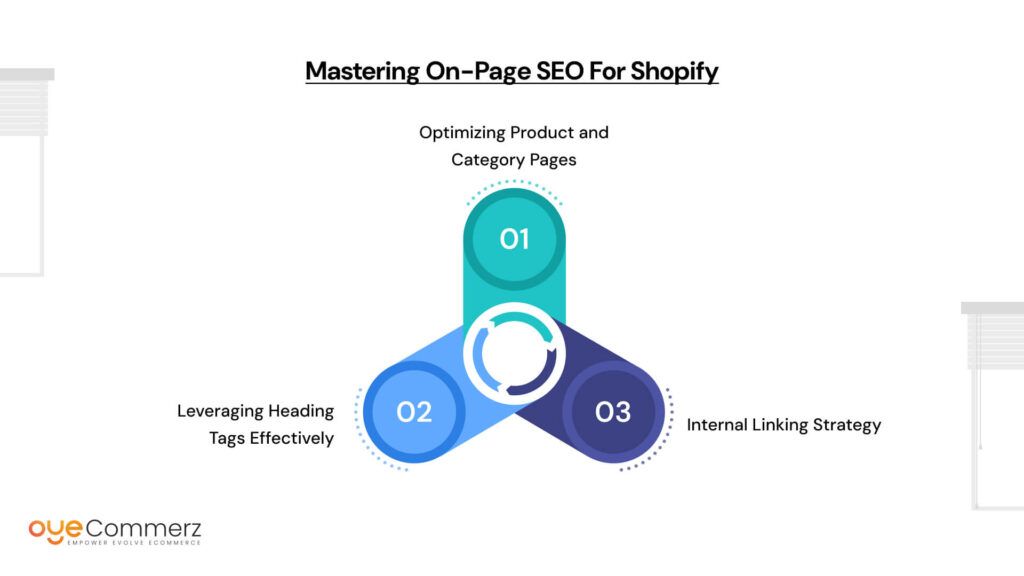
Optimizing Product and Category Pages
Your product and category pages are where conversions happen, so they need to be fully optimized for SEO. Start by crafting compelling meta titles and descriptions that include relevant keywords. A well-written meta description encourages clicks by providing a concise summary of the page.
Best Practices for Product and Category Optimization:
- Meta Titles: Include primary keywords naturally and keep titles under 60 characters.
- Meta Descriptions: Add relevant keywords and make it engaging to entice users to click (limit to 160 characters).
- Product Descriptions: Avoid copying manufacturer descriptions. Write unique, engaging, and keyword-rich content that highlights the product’s features and benefits.
Leveraging Heading Tags Effectively
Heading tags (H1, H2, H3, etc.) structure your content and help search engines understand the page’s hierarchy. Misusing or ignoring these tags can confuse search engines and hurt your SEO efforts.
Best Practices for Using Heading Tags:
- H1 Tag: Use only one H1 per page, usually the product or category name.
- H2 and H3 Tags: Break down the content into sections and subsections.
- Avoid Keyword Stuffing: Use keywords naturally in headings without forcing them.
Example:
- H1: Nike Air Max 2024 – Lightweight & Durable Running Shoes
- H2: Key Features and Benefits
- H3: Available Colors and Sizes
Internal Linking Strategy
Internal linking not only improves user experience by guiding visitors to relevant pages but also helps search engines understand the structure of your site. It distributes link equity across pages, boosting the authority of important product or category pages.
Why Internal Linking is Essential:
- Improves Crawling and Indexing: Search engines follow internal links to discover and index pages.
- Reduces Bounce Rate: Engages visitors by guiding them to related content.
- Pass Link Equity: Helps boost the SEO performance of linked pages.
Best Practices for Internal Linking:
- Use relevant anchor text that includes target keywords.
- Link to related products, categories, and blog posts.
- Avoid overloading pages with too many links – keep it natural and user-friendly.
By mastering these on-page SEO techniques, you can significantly enhance your Shopify store’s visibility, attract more organic traffic, and increase conversions.
Enhancing Technical SEO in Shopify
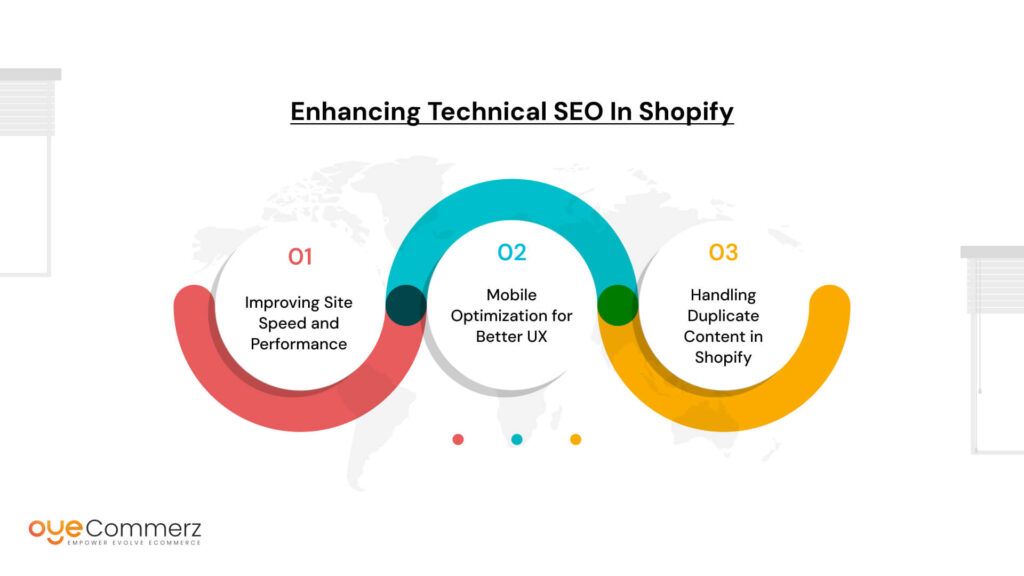
Improving Site Speed and Performance
A slow website can kill conversions and hurt SEO rankings. Google prioritizes fast-loading sites because users expect pages to load in under 3 seconds. For Shopify stores, optimizing speed should be a top priority to retain visitors and boost SEO.
How to Improve Site Speed:
- Optimize Images: Large, uncompressed images slow down your site. Use tools like TinyPNG or ImageOptim to compress images without sacrificing quality. Also, consider using WebP format for faster loading.
- Minify CSS, JavaScript, and HTML: Remove unnecessary code spaces and comments to reduce file size. Shopify’s theme.liquid file should be optimized to keep the code lean and clean.
- Enable Lazy Loading: Lazy loading delays loading of non-critical images and videos until the user scrolls down. This drastically reduces initial page load time and improves site speed.
Faster site speed equals better user experience, higher search rankings, and ultimately, more conversions!
Mobile Optimization for Better UX
With over 72% of eCommerce traffic coming from mobile devices, ensuring that your Shopify web development results in a mobile-friendly store is non-negotiable. Google follows a mobile-first indexing approach, meaning it prioritizes your site’s mobile version when determining rankings.
Best Practices for Mobile Optimization:
- Responsive Design: Use a responsive theme that adjusts seamlessly across devices. Shopify’s free and premium themes are built with responsiveness in mind.
- Optimize Tap Targets: Ensure buttons and links are easy to tap without zooming. A minimum touch target size of 48×48 pixels is ideal.
- Prioritize Above-the-Fold Content: Ensure that critical content (like CTAs and product info) is loaded above the fold for faster user interaction.
A mobile-first approach keeps users engaged and helps your Shopify store rank higher in search results.
Handling Duplicate Content in Shopify
Duplicate content can confuse search engines and dilute your SEO efforts. Shopify automatically generates multiple URLs for product variants, which can lead to duplicate content issues.
How to Fix Duplicate Content:
- Set Up Canonical Tags: Canonical tags tell search engines which URL is the “main” version of a page. Shopify adds canonical tags automatically, but you can fine-tune them to prevent duplicate content.
- Use 301 Redirects: If you change a product URL or remove a page, implement a 301 redirect to guide users and search engines to the correct page. This preserves link equity and prevents broken links.
Managing duplicate content effectively keeps your store’s SEO clean and boosts your ranking potential.
Leveraging Advanced SEO Tactics for Shopify
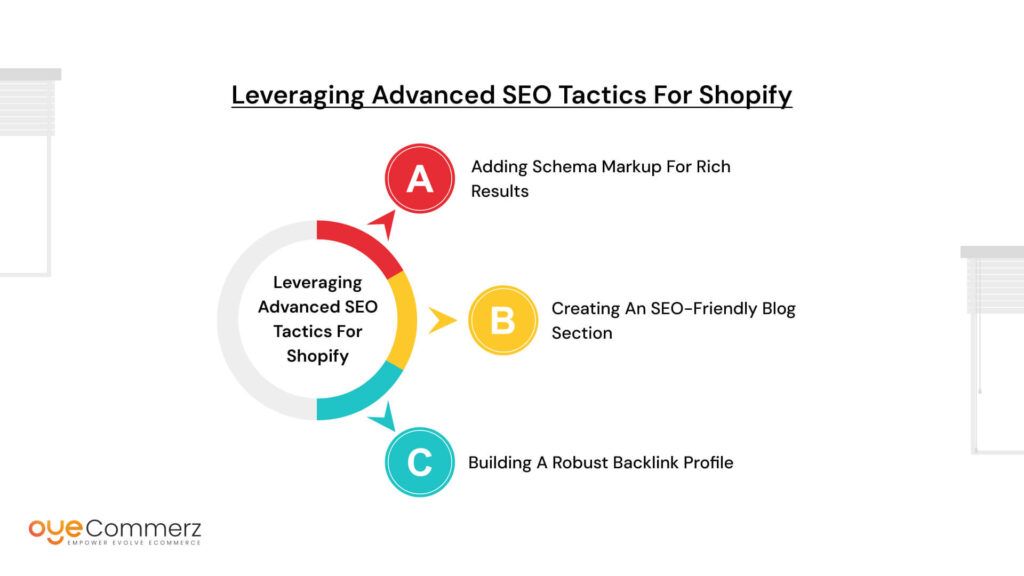
Adding Schema Markup for Rich Results
Want to stand out in Google’s search results? Schema markup helps your Shopify store display rich results such as product ratings, prices, and FAQs, making your listings more eye-catching and informative.
What is Schema Markup?
Schema markup is a type of structured data that helps search engines understand your page content better. When implemented correctly, it enables Google to display rich snippets, increasing your click-through rate (CTR).
Steps to Add Schema Markup in Shopify:
- Choose the Right Schema Type: Common types include Product, Review, and FAQ schema.
- Add JSON-LD Code to theme.liquid: Insert the structured data between the <head> tags of your Shopify theme.
- Use an SEO App: If coding isn’t your thing, apps like JSON-LD for SEO can automate the process.
Schema markup not only improves visibility but also builds trust by providing valuable information upfront.
Creating an SEO-Friendly Blog Section
Content is king in SEO, and an active blog can drive consistent organic traffic to your Shopify store. Blogging allows you to target long-tail keywords, answer customer queries, and establish authority in your niche.
Tips to Create High-Quality Blog Content:
- Focus on Evergreen Topics: Write blogs that provide long-term value, such as “How to Choose the Best Sneakers” or “10 Tips for Maintaining Leather Shoes.”
Optimize Blog Posts for SEO:
- Include primary and secondary keywords naturally.
- Use compelling meta titles and descriptions.
- Add internal links to relevant product pages.
Include Visuals and Multimedia: Use high-quality images, infographics, and videos to make the content engaging and SEO-friendly.
A well-maintained blog boosts your site’s authority, attracts backlinks, and drives traffic that converts.
Building a Robust Backlink Profile
Backlinks (links from other websites to your store) are like votes of confidence that tell Google your site is trustworthy. A strong backlink profile can significantly improve your Shopify store’s domain authority and search rankings.
Strategies to Earn High-Quality Backlinks:
- Guest Posting: Collaborate with industry-related blogs and websites to publish high-value guest posts that link back to your Shopify store.
- Influencer Outreach: Partner with influencers to review your products and link back to your site.
- Resource Link Building: Create valuable content, such as guides or tools, that other sites will naturally link to.
Why Backlinks Matter for Shopify SEO:
- Boosts domain authority and trustworthiness.
- Improves search rankings for target keywords.
- Increases referral traffic and brand visibility.
Investing in a solid backlink strategy helps your Shopify store gain credibility and stay ahead of the competition.
Optimizing Shopify for Local SEO
Importance of Local SEO for eCommerce
If your Shopify store has a physical location or caters to specific regions, local SEO can drive highly targeted traffic. Even for online-only stores, optimizing for local search improves trust and visibility. According to a study, 76% of people who search for something nearby visit a store within 24 hours, a massive opportunity for conversions!
Why Local SEO Matters:
- Improved Visibility in Local Searches: Appear in Google’s Local Pack and Maps.
- Increased Foot Traffic: Local SEO attracts nearby customers looking for your product.
- Higher Conversion Rates: Local searches often result in faster conversions.
Creating Google My Business (GMB) Profile
Setting up a Google My Business (GMB) profile is a critical step for local SEO. It helps your store appear in local search results and provides key business information to potential customers.
Steps to Set Up and Optimize GMB:
- Sign Up and Claim Your Business: Go to Google My Business and create or claim your listing.
- Add Complete Business Information: Include name, address, phone number, website, and business hours.
- Upload High-Quality Images: Add photos of your store, products, and team.
- Encourage Customer Reviews: Positive reviews improve credibility and rankings.
An optimized GMB profile ensures that your Shopify store is visible to local customers searching for relevant products.
Using Location-Based Keywords
Integrating location-based keywords into your product and category pages helps you rank higher for local searches. Whether you sell region-specific items or serve a particular area, localized keywords make your Shopify web development efforts more effective and your store more discoverable.
Best Practices for Adding Local Keywords:
- Include City and Region Names: Mention your location in product titles, descriptions, and meta tags.
- Add Location to URLs: Use SEO-friendly URLs with geographic terms where relevant.
- Utilize Blog Content: Write location-specific content to target long-tail keywords.
By optimizing for local SEO, you not only increase visibility but also drive more targeted, high-intent traffic to your Shopify store.
Utilizing Shopify Apps and Tools to Boost SEO
Best SEO Apps for Shopify
Optimizing a Shopify store manually can be time-consuming, but luckily, Shopify’s App Store offers powerful SEO apps to simplify the process. These apps automate key SEO tasks, improve your site’s structure, and help you stay ahead of the competition.
Top SEO Apps for Shopify:
- Yoast SEO: Known for its ease of use, Yoast helps optimize meta titles, descriptions, and content for target keywords. It also provides real-time SEO suggestions to ensure your pages rank higher.
- Plug in SEO: This app scans your store for SEO issues and provides actionable recommendations to fix them. It’s great for identifying broken links, missing alt text, and optimizing meta content.
- SEO Manager: SEO Manager offers a comprehensive solution with features like 404 error tracking, keyword suggestions, and automatic sitemap updates.
These apps streamline your SEO workflow and keep your Shopify store optimized for search engines.
Tracking and Analyzing SEO Performance
SEO is not a one-time task, it requires continuous tracking and refinement. To measure the success of your Shopify store’s SEO efforts, you’ll need the right analytics tools.
Google Analytics: Monitor website traffic, user behavior, and conversion rates. Identify which pages are performing well and where improvements are needed.
Google Search Console: Keep an eye on your store’s search performance. Analyze keyword rankings, monitor backlinks, and fix crawl errors to maintain SEO health.
Regularly analyze your keyword rankings and organic traffic to fine-tune your SEO strategy and identify opportunities for improvement.
Avoiding SEO Mistakes with Automation
Manually managing SEO across a growing store can lead to errors and inconsistencies. Automating SEO tasks not only saves time but also reduces the risk of mistakes that can hurt your rankings.
Benefits of SEO Automation:
- Error Reduction: Automatically generate and update meta titles, descriptions, and alt text.
- Consistency Across Pages: Ensure uniform SEO practices across all product and category pages.
- Time Efficiency: Focus on strategy while automation handles repetitive tasks.
With Shopify web development, your Shopify store can maintain consistent performance and achieve long-term success.
Content Marketing Strategies to Amplify SEO
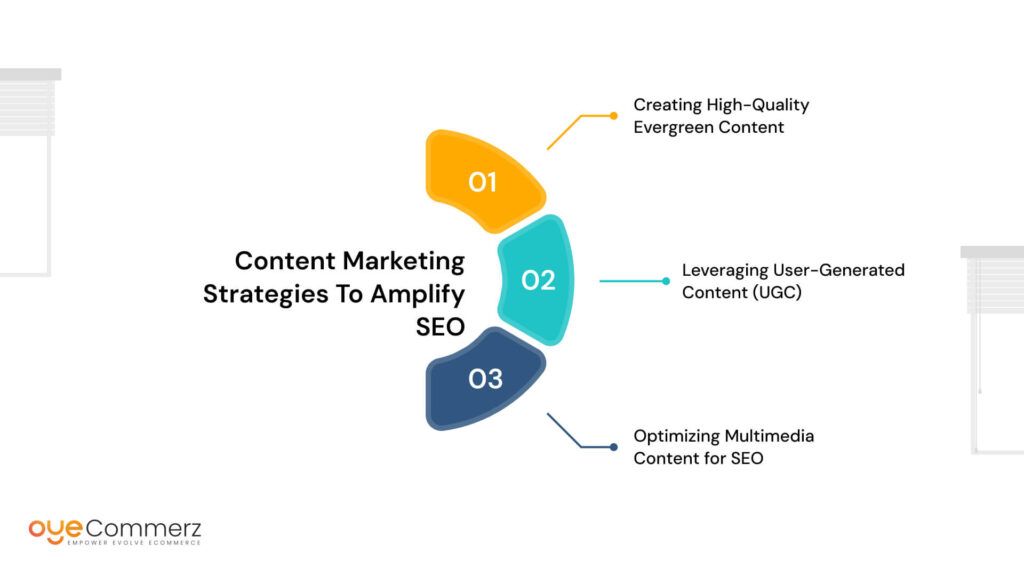
Creating High-Quality Evergreen Content
Evergreen content is content that remains relevant and valuable over time, making it a powerful asset for boosting SEO. Unlike trending content that fades quickly, evergreen pieces continue to drive organic traffic and build authority long after they are published.
Why Evergreen Content Matters:
- Sustained Traffic: High-quality evergreen posts continue to attract visitors and rank higher over time.
- Improved Authority: Consistently providing valuable content positions your Shopify store as an industry leader.
Examples of Evergreen Content for Shopify:
- How-To Guides: Tutorials on product usage or maintenance.
- Product Comparisons: In-depth reviews that help customers make informed decisions.
- FAQs and Troubleshooting Tips: Answers to common customer queries that remain relevant.
Leveraging User-Generated Content (UGC)
User-generated content (UGC), such as product reviews, testimonials, and social media mentions, can greatly enhance your Shopify store’s SEO. Search engines value fresh, authentic content that reflects user engagement and trust.
Why UGC Boosts SEO:
- Increases Content Volume: Reviews and testimonials add fresh, keyword-rich content to your product pages.
- Improves Trust and Credibility: Positive reviews enhance your store’s reputation and influence purchase decisions.
Encourage customers to leave reviews by offering incentives like discounts or loyalty points. Feature UGC prominently on product pages to boost conversions and SEO simultaneously.
Optimizing Multimedia Content for SEO
Visual content like images and videos can enrich the user experience and improve SEO if optimized correctly. Search engines can’t “see” images or videos, so providing relevant metadata helps them understand and rank your content.
Best Practices for Optimizing Multimedia Content:
- Add Alt Text to Images: Use descriptive, keyword-rich alt text to help search engines understand image content.
- Optimize Video Titles and Descriptions: Include target keywords naturally in video metadata.
- Compress Multimedia Files: Reduce file sizes to maintain fast page speed and avoid SEO penalties.
By incorporating these content marketing strategies, your Shopify store can attract more organic traffic and build lasting customer relationships.
Securing Your Shopify Store with HTTPS
Why HTTPS is Important for SEO
Google prioritizes secure websites in search rankings, making HTTPS an essential factor for SEO success. HTTPS (Hypertext Transfer Protocol Secure) encrypts data between the browser and the server, protecting sensitive information and enhancing trust.
Impact of HTTPS on SEO:
- Higher Search Rankings: Google gives preference to HTTPS-enabled sites, improving your visibility.
- Enhanced Security: Protects customer data, preventing cyber threats and improving user trust.
- Better User Experience: Users feel more confident when they see the secure padlock icon in the browser.
Without HTTPS, your Shopify store risks losing traffic, trust, and conversions.
How to Enable HTTPS in Shopify
Securing your Shopify store with HTTPS is simple and takes only a few steps.
Steps to Enable HTTPS:
- Log in to Your Shopify Admin Panel.
- Go to Online Store > Domains.
- Check Domain Status: If your domain is eligible for HTTPS, Shopify will automatically apply an SSL certificate.
- Verify SSL Activation: Once enabled, a padlock icon will appear next to your store’s URL.
By enabling HTTPS, you not only protect your customers but also give your Shopify store an SEO boost that improves search rankings and customer trust.
Promoting Your SEO-Optimized Store for Maximum Visibility
Leveraging Social Media for SEO
Social media doesn’t directly impact search rankings, but it plays a crucial role in driving traffic and enhancing brand visibility, both of which can indirectly boost SEO. When your content gets shared on platforms like Instagram, Facebook, and Twitter, it generates more clicks, visits, and engagement. These social signals tell search engines that your content is valuable, which can lead to higher rankings.
How to Use Social Media for SEO:
- Share Product Pages and Blog Content: Post regularly and encourage sharing.
- Engage with Your Audience: Respond to comments and encourage discussions to boost visibility.
- Use Hashtags Smartly: Optimize posts with relevant hashtags to reach a wider audience.
Collaborating with Influencers
Influencer marketing is a powerful way to build brand awareness, drive traffic, and earn high-quality backlinks. When influencers mention or review your Shopify store, it not only increases exposure but also generates authoritative backlinks that boost SEO.
Benefits of Influencer Partnerships:
- Increased Traffic and Credibility: Influencers bring trust and loyal followers.
- Quality Backlinks: Backlinks from reputable sources enhance domain authority.
Partnering with relevant influencers can give your Shopify store a significant SEO boost while building lasting relationships with your target audience.
Maintaining SEO Health with Regular Audits
Importance of SEO Audits
SEO is not a “set it and forget it” task. Regular audits are essential to identify and fix issues that may be hindering your store’s search performance. Over time, broken links, slow-loading pages, and duplicate content can creep in, negatively impacting your rankings.
Why SEO Audits Matter:
- Identify Technical Errors: Fix crawling and indexing issues before they affect rankings.
- Track Keyword Performance: See which keywords are driving traffic and optimize accordingly.
- Maintain a Healthy Site Structure: Ensure your Shopify store remains SEO-friendly as it grows.
Tools to Perform Shopify SEO Audits
Performing regular audits is easier when you have the right tools in your arsenal.
Top Tools for SEO Audits:
- Ahrefs: Comprehensive backlink analysis and keyword tracking.
- SEMrush: Identifies technical SEO errors and tracks keyword performance.
- Screaming Frog: Crawls your Shopify store to detect broken links, duplicate content, and other SEO issues.
Regular audits ensure that your Shopify store stays in peak SEO health and continues to perform well in search results.
Ready to see real results?
OyeCommerz is your go-to expert for Shopify SEO and web development.Contact OyeCommerz today for customized SEO solutions that deliver growth.
Let Experts optimize your store and stay ahead of the competition!
Ready to Migrate to Shopify Plus? Let Us Help You Make the Switch!
Conclusion
In this guide, we’ve covered essential Shopify web development practices that can significantly boost your store’s SEO and increase organic traffic. Starting with the basics of Shopify SEO, we discussed how optimizing site structure, creating SEO-friendly URLs, and using breadcrumbs can enhance both user experience and search engine crawlability.
We explored the importance of mastering on-page SEO by optimizing product pages, leveraging heading tags, and building a strong internal linking strategy. We also highlighted how enhancing technical SEO, through improving site speed, ensuring mobile responsiveness, and resolving duplicate content, can give your store an edge in search rankings.

